Nudibranchs and other Sea Slugs
Order Systellommatophora, Aplysiidae,
& Pteropoda; Superorder Sacoglossa
Aplysiidae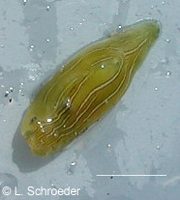
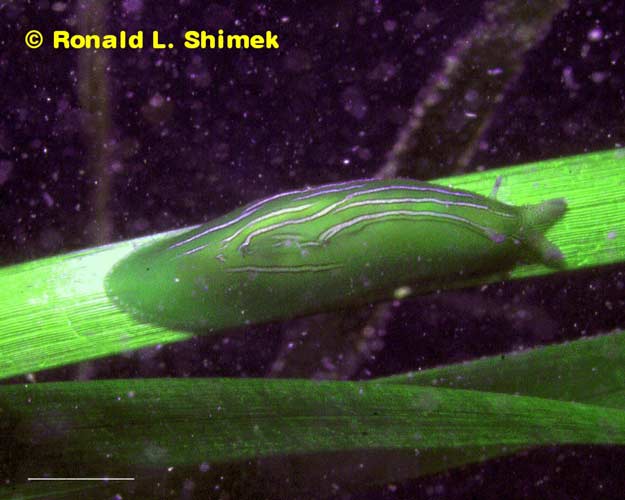
Boundary Bay, BC, intertidal Barkley Sound, BC, subtidal
Order Systellommatophora
Onchidiidae
Deception Pass State Park, WA
Petersburg, AK, intertidal
Seal Rock, OR, intertidal
Onchidella carpenteri (Binney, 1860)
Leather Limpet
intertidal
central California to northern Alaska
size to 15mm
Can be found with a bit of hunting. The species is small and blends into its environment. Despite
its name, it is not closely related to limpets. It is air breathing and
lives in the high intertidal zone.
(synonym - Onchidella borealis)
Clionidae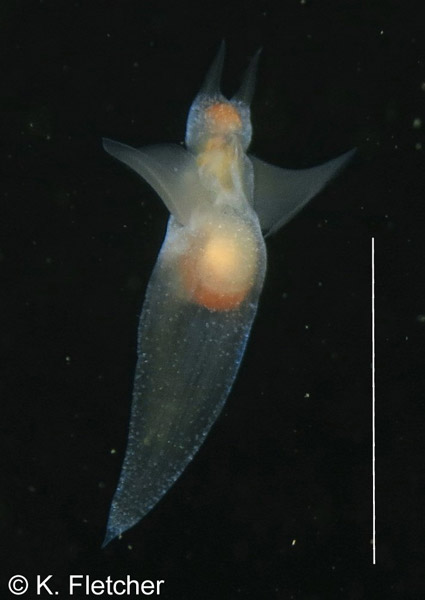

Rich Passage, WA, subtidal Oceanside OR, intertidal
Clione limacina (Phipps, 1774)
Sea Angel
pelagic to 600m size to 80mm
all northern cold and temperate seas,
locally - northern Mexico to Arctic
This pteropod species swims through the water and can be very abundant. It is carnivorous and feeds on other pteropods.
(previous name - Clio limacina)
Order Pteropoda
Order Aplysiidae
.
Cymbuliidae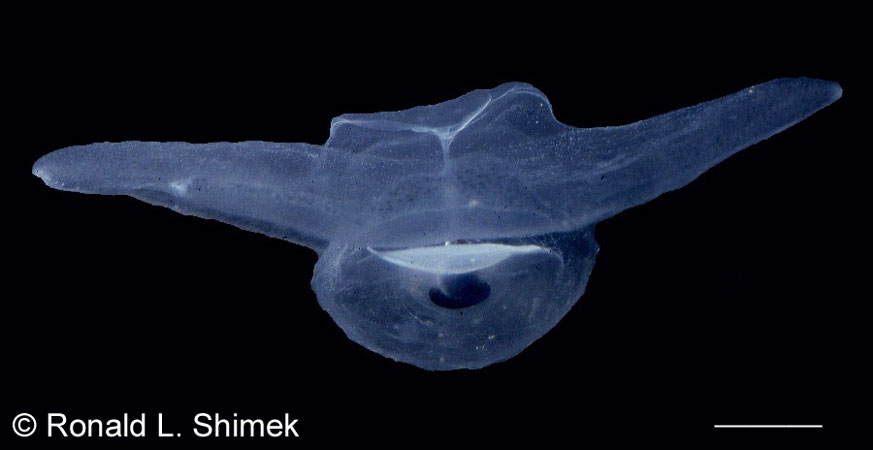 Friday Harbor, WA, subtidal
Friday Harbor, WA, subtidal
Corolla spectabilis Dall, 1871Spectacular Corolla or Sea Butterflypelagic size to at least 8cmeastern Pacific Ocean; western Atlantic Ocean; Hawaii; Japan; Mediterranean SeaThis species "flies" through the water. Rather than an external shell, it possesses a
gelatinous internal pseudoconch. It can be very abundant in the
water and occasionally the gelatinous pseudoconch can wash up on the
beach.
This page last revised: 5-25-2019
Phyllaplysia taylori Dall, 1900
Zebra Leafslug or Taylor's Seahare
intertidal to subtidal on the eel grass Zostera
southern California to central BC size to 8cm
Look near the base of Zostera, between the
blades, to find this species. It is well-camouflaged.
(synonym - Phyllaphysia zostericola)
Superorder Sacoglossa
Hermaeidae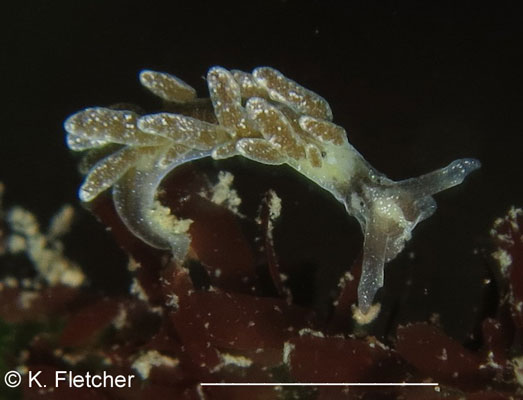 Turn Island, WA, subtidalAplysiopsis enteromorphae (Cockerell & Eliot, 1905)Enteromorpha-eating Sapsuckerintertidal to shallow subtidal size to 25mmsoutheast Alaska to northern MexicoThis
tiny species is difficult to spot. It feeds on filamentous green
algae. It may be yellowish to dark brown with greenish-black
patches. The cerata usually have dark lines.(previous name - Aplysiopsis smithi)
Turn Island, WA, subtidalAplysiopsis enteromorphae (Cockerell & Eliot, 1905)Enteromorpha-eating Sapsuckerintertidal to shallow subtidal size to 25mmsoutheast Alaska to northern MexicoThis
tiny species is difficult to spot. It feeds on filamentous green
algae. It may be yellowish to dark brown with greenish-black
patches. The cerata usually have dark lines.(previous name - Aplysiopsis smithi)
Rich Passage, WA, subtidal
Hazard Canyon, CA,
intertidal
Hermaea oliviae (MacFarland, 1966)
Olivia's Sapsucker
intertidal to shallow subtidal northern Mexico to southern BC size to 10mm
Its
small size makes it difficult to find. Search for it on
filamentous green algae. The body is decorated with mahogany
colored lines.
(previous name - Aplysiopsis oliviae)
Limapontiidae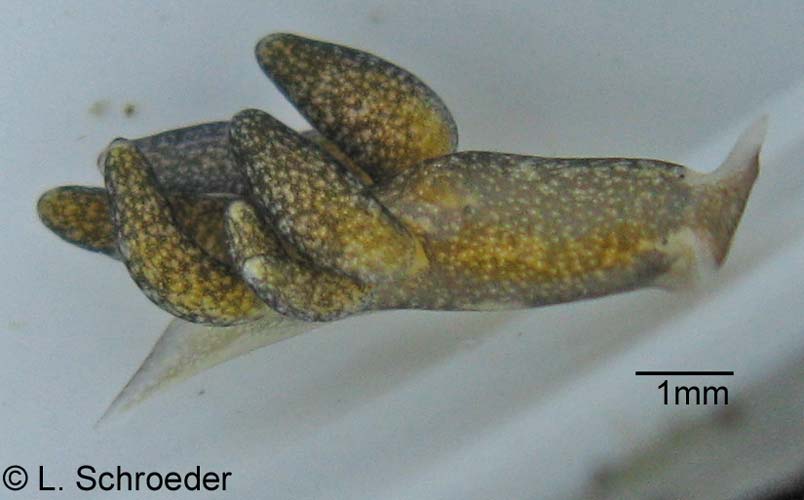 Oak Bay, WA, intertidalOlea hansineensis Agersborg, 1923Hansine's Egg Eater intertidal to shallow subtidal size to 13mmsouthern California to southern AlaskaThis specimen was found feeding on Haminoea vesicula eggs.This species is very small and hard to spot.
Oak Bay, WA, intertidalOlea hansineensis Agersborg, 1923Hansine's Egg Eater intertidal to shallow subtidal size to 13mmsouthern California to southern AlaskaThis specimen was found feeding on Haminoea vesicula eggs.This species is very small and hard to spot.
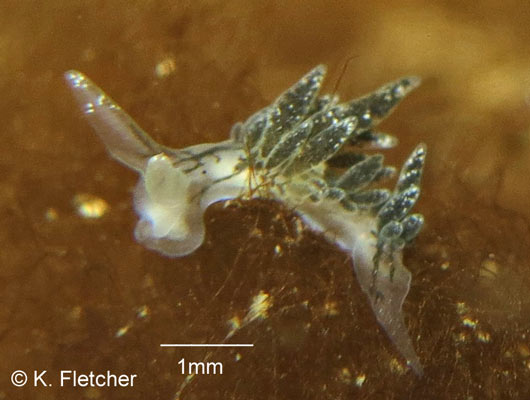 Rich Passage, WA, subtidalPlacida dendritica (Alder & Hancock, 1843)Branched Sapsucker intertidal to shallow subtidal size to 8mmcentral Mexico to AlaskaIts small size makes it difficult to find. The light colored body is marked with branching greenish lines.
Rich Passage, WA, subtidalPlacida dendritica (Alder & Hancock, 1843)Branched Sapsucker intertidal to shallow subtidal size to 8mmcentral Mexico to AlaskaIts small size makes it difficult to find. The light colored body is marked with branching greenish lines.
Rich Passage, WA, subtidal
Seal Rock, OR, intertidal
Stiliger fuscovittatus Lance, 1962
Brown-streaked Sapsucker
intertidal to subtidal size to 15mm
north Mexico to Ketchikan, AK
This
small species is often overlooked among the red filamentous alga.
It has a pale colored body with reddish-brown spots and irregular
lines.
Plakobranchidae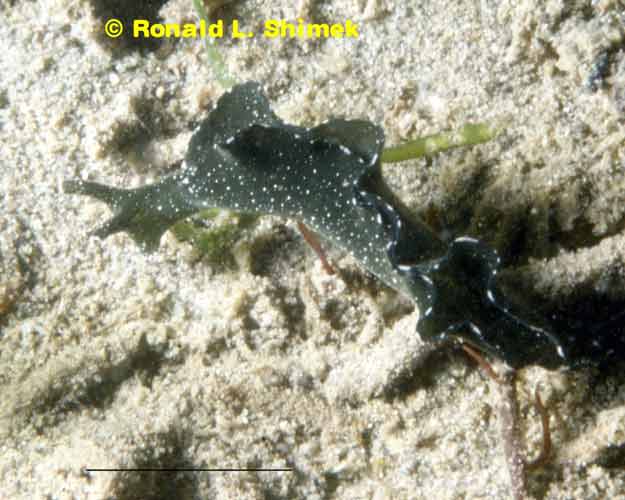
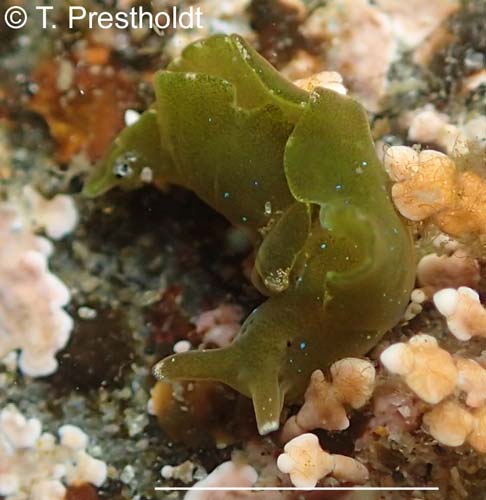
Dyes Inlet, WA, subtidal
Otter Crest, OR,
intertidal
Elysia hedgpethi Marcus, 1961
Hedgpeth's Sapsucker
intertidal to shallow subtidal size to 35mm
northern Mexico to southern BC
It is infrequently seen intertidally. It is
well-camouflaged on the dark plants it prefers.
Click on photo to enlarge. Scale line in photo equals 1cm unless otherwise specified.
* Species which are the most commonly encountered nudibranchs on the beach.






